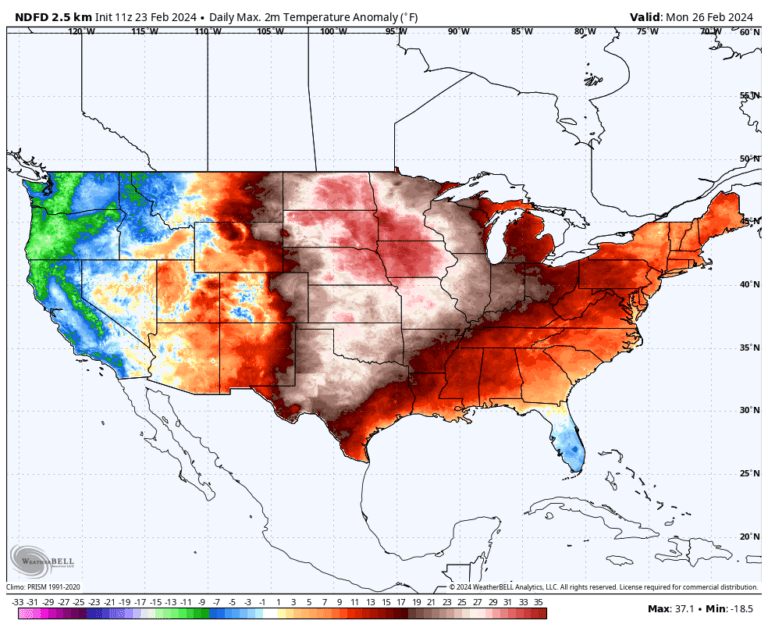The heat is expected to surge north ahead of a powerful low pressure system that will sweep across the country. As it pulls warm and moist air northward, it should also produce fuel for Strong thunderstorms possible across parts of the Midwest and South on Tuesday and Wednesday.
The expected mild weather could help deliver the warmest climatological winter (defined as December through February) on record for the Lower 48 and leave many people wondering where the season went.
As a taste of what's to come, temperatures reached 94 degrees Wednesday in Rio Grande Village, Texas, near the Mexican border. Widespread highs in the 80s spread north into Oklahoma.
Among other area records, he reached 83 degrees in Amarillo, Texas, and Oklahoma City.
The heat and lack of winter storms since last weekend have taken their toll again Record low snowfall averaged in the lower 48 and Great Lakes ice continues to be at record lows.
The spring weather cycle set for early next week will swell over a much larger area, producing highs in the 80s and 90s again in the south central United States, while the 60s spread as far north as Minneapolis and Green Bay, Wis.
By the time this warm spell ends later next week, most places east of the Rockies and north of the Gulf Coast will likely have challenged or set warm weather records.
Hundreds of records to fall
An extraordinary number of Calendar day warm weather records are forecast early next week.
Overnight temperatures will likely be particularly mild. Hundreds of warm overnight record lows are at risk between Monday and Wednesday. On Tuesday, lows will only drop near 60 in St. Louis and around 50 in Chicago. this is much warmer than the average afternoon high.
By Wednesday, much of the Mid-Atlantic will have lows in the 50s, which is also warmer than normal afternoon highs.
The afternoon highs themselves will also be unusually warm and set records in many places. About 50 record highs could be set on both Monday and Tuesday. On Monday, many of the records are viewed across the Plains and Midwest before moving into the band from the southern Plains to the Great Lakes on Tuesday.
On Monday, temperatures are forecast to soar into the low to mid 90s in South Texas, upper 80s in Kansas, and into the 60s in North Dakota and Minnesota.
Tuesday's highs could soar near 70 in the Great Lakes and Ohio Valley. By Wednesday, warmer weather will shift into the mid-Atlantic and Northeast with highs in the 60s and 70s.
Here are several locations that could set record highs between Monday and Wednesday:
- Dallas: 90 degrees Monday (27 degrees above normal).
- Little Rock: 80 degrees Tuesday (22 degrees above normal).
- St. Louis: 79 degrees Tuesday (29 degrees above normal).
- Des Moines: 72 degrees Monday (32 degrees above normal).
- Washington Dulles International Airport: 70 degrees Wednesday (21 degrees above normal).
- Toledo: 66 degrees Tuesday (22 degrees above normal).
- Rochester, NY: 63 degrees Wednesday (25 degrees above normal).
In much of the affected area, high temperatures will be at least 20 to 25 degrees above normal for a day or two. Some areas in the Midwest and Northeast will likely see high temperatures 30 to 40 degrees above normal.
A tame end to a toothless climatic winter
Aside from a brief cold snap or two, winter has been largely absent for much of the eastern two-thirds of the Lower 48 and especially in the Great Lakes region.
The average temperature from Fargo, ND, to International Falls, Minn., is 12 to 15 degrees above normal in what will be the warmest winter on record for this region. There are many locations from the Upper Midwest to the Northeast that will complete their warmest winter.
After a December with barely a whiff of cold air, mid-January produced a record flurry of cold weather. Even so, there was a pulse of milder weather at the end of the month that set hundreds more warm weather records.
The weather pattern in February more or less mimicked December – as the cold air went into hibernation again. So far this month, not even counting warm weather records in the works, there have been 1,800 warm weather records, compared to just 129 cold records.
As of December, the number of warm records is about 7,600 versus 2,300 cold records. In a stable climate, these numbers would be much more even.
Both human-induced climate change and the strong El Niño climate are driving this exceptionally warm winter season.
The weather pattern is likely to change to a cooler one by mid-March due to an expected break in the polar vortex. However, scientists are not sure how this will be done.
Jason Samenow contributed to this report.

